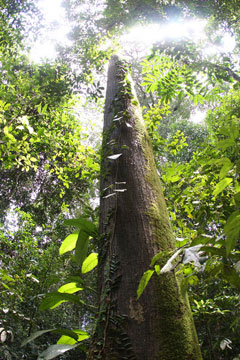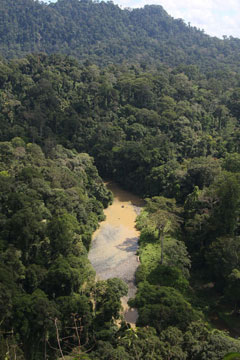Forest conservation can fight climate change and poverty
mongabay.com
October 8, 2008
|
|
The Forests Dialogue — a coalition consisting of more than 250 representatives of governments, forestry companies, trade unions, environmental and social groups, international organizations, forest owners, indigenous peoples and forest-community groups — has issued guiding principles for including forests in climate change negotiations.
The initiative also released a statement calling for sustainable forest management that reduces deforestation, helps fight climate change, and supports rural livelihoods to be made a global priority.
"For the first time on this unprecedented scale, forest leaders, business representatives, donors, and community groups not only agreed on the pivotal role that forests can play in mitigating climate change but also mapped out a consensus action plan on concrete next steps. We now ask the world to work with us in putting these guiding principles into action," said Stewart Maginnis, Head of IUCN's Forest Conservation Program.
The statement and the guiding principles appear below.
Beyond REDD: The Role of Forests in Climate Change
A Statement from The Forests Dialogue
The Forests Dialogue's Initiative on Forests and Climate Change agrees that: Of all the options for responding to climate change, forest-related mitigation measures are, in the short to medium term, among the most practicable and cost-effective. They also have very low opportunity costs and can make an immediate and direct contribution to sustainable development and rural livelihoods.
 Danum Valley. Photos by Rhett A. Butler |
Deforestation and forest degradation produce about 20% of the world's greenhouse gas emissions. Yet the forests sector also has a unique ability to simultaneously reduce emissions, capture and store carbon, and lessen the vulnerability of people and ecosystems to climate change. Measures such as sustainable forest management, forest conservation, reforestation, forest restoration, afforestation, wood-based bioenergy generation, and the use of sustainably produced wood products as substitutes for emissions-intensive materials, therefore, should all be considered as part of the global approach to climate change mitigation and adaptation. However, forest-based climate change responses should be designed as a complement, rather than an alternative, to strategies for reducing fossil fuel emissions. A strong focus on forests should diminish neither the need for clear emissions limits nor the climate change mitigation responsibilities of the Kyoto Protocol's Annex 1 countries.
Experience within the forest community has shown that, in the long run, a narrow focus on a single commodity—such as carbon—at the expense of wider forest values is unlikely to succeed. Moreover, a piecemeal approach to forests would risk undermining the social, environmental, and economic resilience of rural communities and could directly reduce their ability to adapt to climate change. To be effective, forest-based mitigation and adaptation measures must deliver sustainable development, build resilience in rural communities, and fully involve forest-dependent people, civil society, the forest workforce, and the private sector. The implementation of measures for forest-based climate change mitigation and adaptation provides both opportunities and risks for Indigenous Peoples and other marginalized groups. The United Nations Declaration on the Rights of Indigenous Peoples is therefore of particular relevance and should be comprehensively applied in negotiations with Indigenous Peoples under relevant treaties and in recognizing their rights and tenure. Consistency with the obligations of countries under international laws on human rights, the environment, and trade is also fundamental.
GUIDING PRINCIPLES
Five principles, described below, should guide forest-related post-2012 arrangements on climate change. To support these principles, a set of possible actions (presented in an annex to this document) has been formulated.
1. Ensure that forest-related climate change options support sustainable development in both forest-rich and forest-poor countries.
Forest-based strategies for climate change mitigation and adaptation must support sustainable development. This applies equally in forest-rich countries, where opportunities for climate change mitigation are high but the need for adaptation might be neglected, and in forest-poor countries, where attention might be paid to adaptation but not to the potential for mitigation. There will be no ‘one size fits all' solution: countries should consider the full range of options and choose those that best complement their needs and sustainable development efforts.
 Danum Valley. Photos by Rhett A. Butler |
If interpreted narrowly, measures to reduce emissions from deforestation and forest degradation in developing countries (REDD) are most likely to favor countries that have high deforestation rates and therefore the ability to achieve deep cuts in emissions by reducing such deforestation. Provision should be made, however, to also reward countries and communities that are already conserving, sustainably managing and expanding their forests, including high-forest, low-deforestation (HFLD) countries.
The most effective forest-based approaches will retain and enhance carbon stocks through such measures as sustainable forest management (SFM), REDD, afforestation, reforestation, the restoration of degraded forest lands, conservation, and the substitution of high-emissions materials and fuels with sustainably produced forest products. They will also increase the resilience of forests to the impacts of climate change and encourage communities to adapt to climate change.
In the past, many responses to climate change have been fragmented, uncoordinated, and contradictory and have led to perverse land-use outcomes. Forest-based approaches can and should be complementary and transparent. They should be fully integrated into poverty reduction strategies and macroeconomic development plans and promoted by uncomplicated financial mechanisms. Above all, they should support sustainable development; if they do not, they will be unable to deliver a significant or quantifiable reduction in deforestation. To boost investor confidence in the viability of forests as a mitigation and adaptation option, the successful experiences already gained in voluntary carbon markets should be fully utilized.
2. Tackle the drivers of deforestation that lie outside the forests sector.
Factors such as expanding agriculture and livestock production, infrastructure development, population growth, urbanization, market distortions, and global demand for agricultural products and biofuels underlie most deforestation and therefore most of the carbon emissions caused by deforestation.
The processes that promote these factors are often well understood but the inter-sectoral engagement mechanisms required to tackle them are lacking. Often, governmental policies, programs, and subsidies are sector-specific and directly and negatively impact the health, integrity, and sustainable management of forest resources.
Perverse incentives that encourage the clearing of land that would otherwise have remained as forest should be identified and removed and positive incentives for landowners and forest dependent people to retain their forests provided.
3. Support transparent, inclusive, and accountable forest governance.
If forest-based activities are to help in climate change mitigation and adaptation, barriers to improved governance must be identified and processes established to empower the disenfranchised, including Indigenous Peoples. Such efforts should be supported with mitigation measures in consumer countries to promote the use of legally and sustainably produced forest products. Encouragingly, several countries have already initiated progressive forest governance reform processes. A systematic connection between such reforms and the establishment of credible programs for REDD and other forest-based approaches to climate change, however, still needs to be developed.
Post-2012 arrangements cannot directly prescribe measures for improved forest governance. They should, however, include provisions for tracking and reporting on progress in forest governance as it pertains to the effectiveness of forests in delivering emissions reductions. This would have the additional benefit of accelerating improvement in the overall governance of the forests sector.
4. Encourage local processes to clarify and strengthen tenure, property, and carbon rights.
 Photo by Rhett A. Butler |
The rights to and tenure of forests are often poorly defined and, in particular, the rights of customary owners are seldom given full recognition. Indigenous Peoples, forest owners, the forest workforce, and local communities are now additionally concerned that their rights to control and benefit from forest-based carbon will be nationally and internationally unacknowledged. This, in turn, will reduce their ability to manage and use their forest resources and to retain their cultures, traditional knowledge systems, and territories. Clarifying carbon rights when basic property rights are still unclear looms as a major challenge. Poorly designed forest-based climate change mitigation measures could undervalue proven traditional and local knowledge systems and the experiences accumulated by customary owners in sustainably managing their resources over many generations. The importance of mapping and securing the tenure, property, and carbon rights of Indigenous Peoples, family forest owners, and local communities, and devising effective mechanisms for the distribution of benefits, cannot be overstated. In addition, future national climate change mitigation regimes must ensure the ability of those groups to conserve and enhance their carbon-related assets and guarantee them the freedom to choose whether and how they trade their carbon rights. Mechanisms to engage and build capacity among local stakeholders so they can participate effectively in decision-making are of fundamental importance.
5. Provide substantial additional funding to build the capacity to put the above principles into practice.
Whatever financial mechanisms within the post-2012 arrangements on climate change are ultimately agreed, it is essential that governments, multilateral institutions, and donors, in close partnership with stakeholders in recipient countries, invest in capacity building, at all levels, for forest-related climate change mitigation and adaptation. Recipient countries should take the lead in defining the kinds of support that are needed and donors should improve their coordination to ensure that the support they provide is complementary.
For capacity building to be useful, governments must implement policies that encourage forest related climate change mitigation and adaptation measures. While immediate investment is urgently required, capacity building is a long-term process and requires consistent support over many years. Investments that assist the development of forest rights and livelihoods are likely to be efficient and effective in promoting climate change mitigation and adaptation.
CONCLUSION
Those who met under the auspices of The Forests Dialogue on Climate Change understand that although individuals, communities, and nations have made widely divergent contributions to the increasing concentration of greenhouse gases in the atmosphere, solving the problem will require a unified global response. Equally, while solutions to climate change must respect national sovereignty and contribute to national development, they must also respect human rights.
The Forests Dialogue on Climate Change recognizes that REDD and other climate change mitigation and adaptation measures will only achieve lasting results if they are adapted to conditions on the ground and help meet the needs of local people. By providing adaptability and supporting livelihoods, sustainable forest management offers an efficient win-win solution. It can ensure healthy and productive forests, underpin robust rural livelihoods, and deliver a wide range of products and ecosystem services that societies demand. It can also be an economically, environmentally, and socially effective way of addressing climate change globally.
The Forests Dialogue
The Forests Dialogue, Yale University, 360 Prospect Street, New Haven, Connecticut, 06511, USA
This statement is the product of a multi-stakeholder process developed and convened by The Forests Dialogue. It expresses the consensus view of more than 250 people from diverse backgrounds, who came together in various forums to debate, over a ten-month period, the role of forests in climate change and the policies being developed to foster that role. The process culminated in the Global Forest Leaders Forum in Washington, DC, United States on 17–18 September 2008. The Forum was attended by leaders of environmental and social groups, businesses, Indigenous Peoples' and forest community groups, trade unions, forest owners, governments, and international organizations.
Related articles
WWF ends contentious debate, will now support effort to fight climate change by saving rainforests
(9/24/2008) WWF, one of the world’s largest environmental groups, says it will now support policy mechanisms that would compensate tropical countries for reducing carbon dioxide emissions generated by deforestation and forest degradation, according to remarks by the group’s president and CEO at an “avoided deforestation” meeting in New York.
Cutting deforestation can fight climate change, reduce poverty and conflict
(9/24/2008) Forest conservation can play a critical role in efforts to reduce greenhouse gas emissions and alleviate poverty, said a prominent group of politicians, development experts, and environmental NGOs meeting in New York City to discuss U.S. climate policy. Organized by Avoided Deforestation Partners, an international policy group, the meeting sought to establish a strategy to highlight the global impact of deforestation and push for the inclusion of tropical forests in domestic climate policy. Attendees included leaders of WWF, the Nature Conservancy, Conservation International, World Vision, Oxfam, Mercy Corps, Care International, and the Union of Concerned Scientists; former Vice President Al Gore; Wangari Maathai, a Nobel Prize-winning activist from Kenya; Bharrat Jagdeo, president of the South American country of Guyana; and executives from a number of carbon-trading and financial firms. The event was hosted by veteran journalist Dan Rather.
 |
U.S. climate policy could help save rainforests
(5/14/2008) U.S. policy measures to fight global warming could help protect disappearing rainforests, says the founding partner of an “avoided deforestation” policy group. In an interview with mongabay.com, Jeff Horowitz of the Berkeley-based Avoided Deforestation Partners argues that U.S. policy initiatives could serve as a catalyst for the emergence and growth of a carbon credits market for forest conservation. REDD or Reducing Emissions from Deforestation and Degradation is a proposed policy mechanism that would compensate tropical countries for safeguarding their forests. Because deforestation accounts for around a fifth of global greenhouse gas emissions, efforts to reduce deforestation can help fight climate change. Forest protection also offers ancillary benefits like the preservation of ecosystem services, biodiversity, and a homeland for indigenous people.